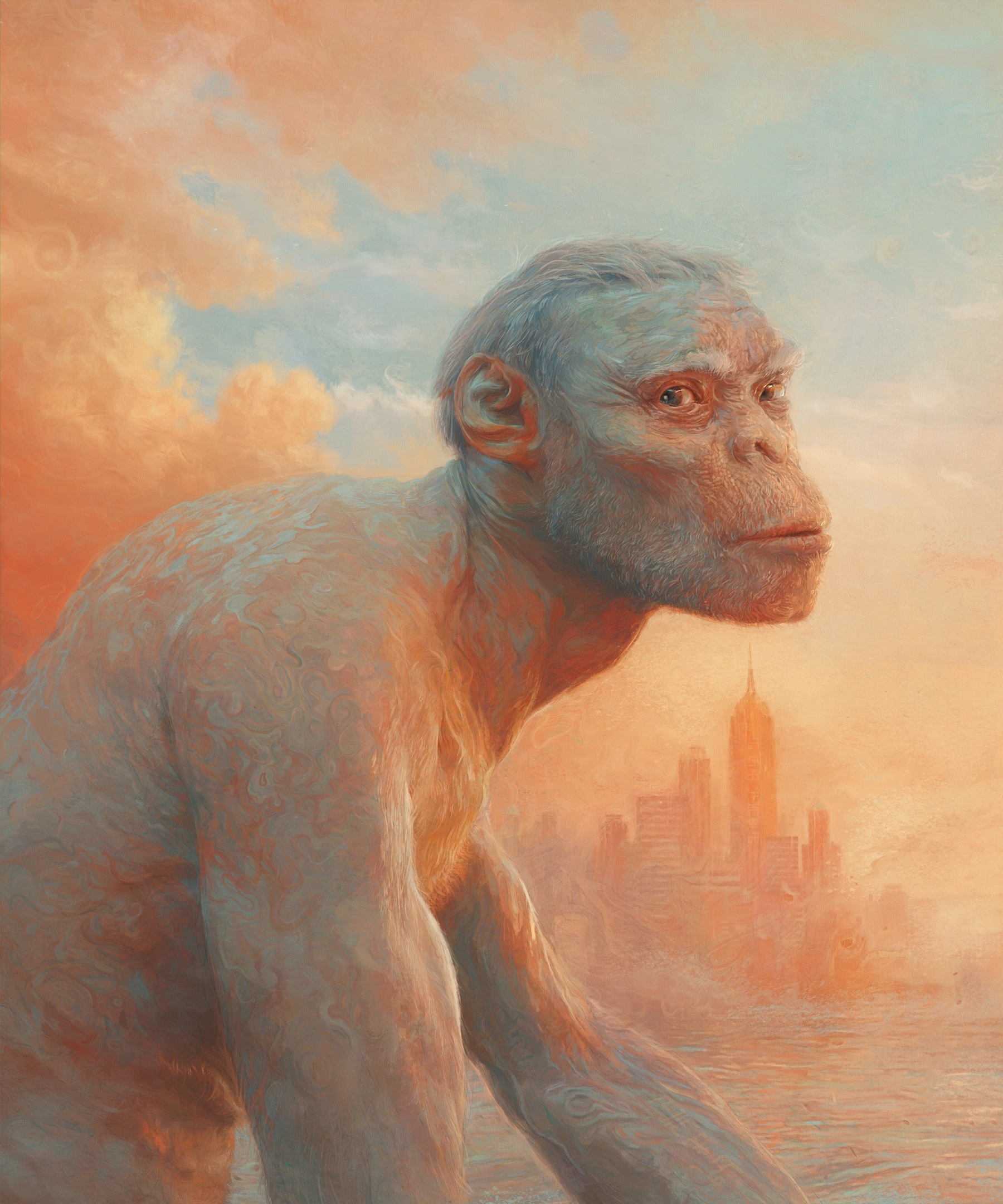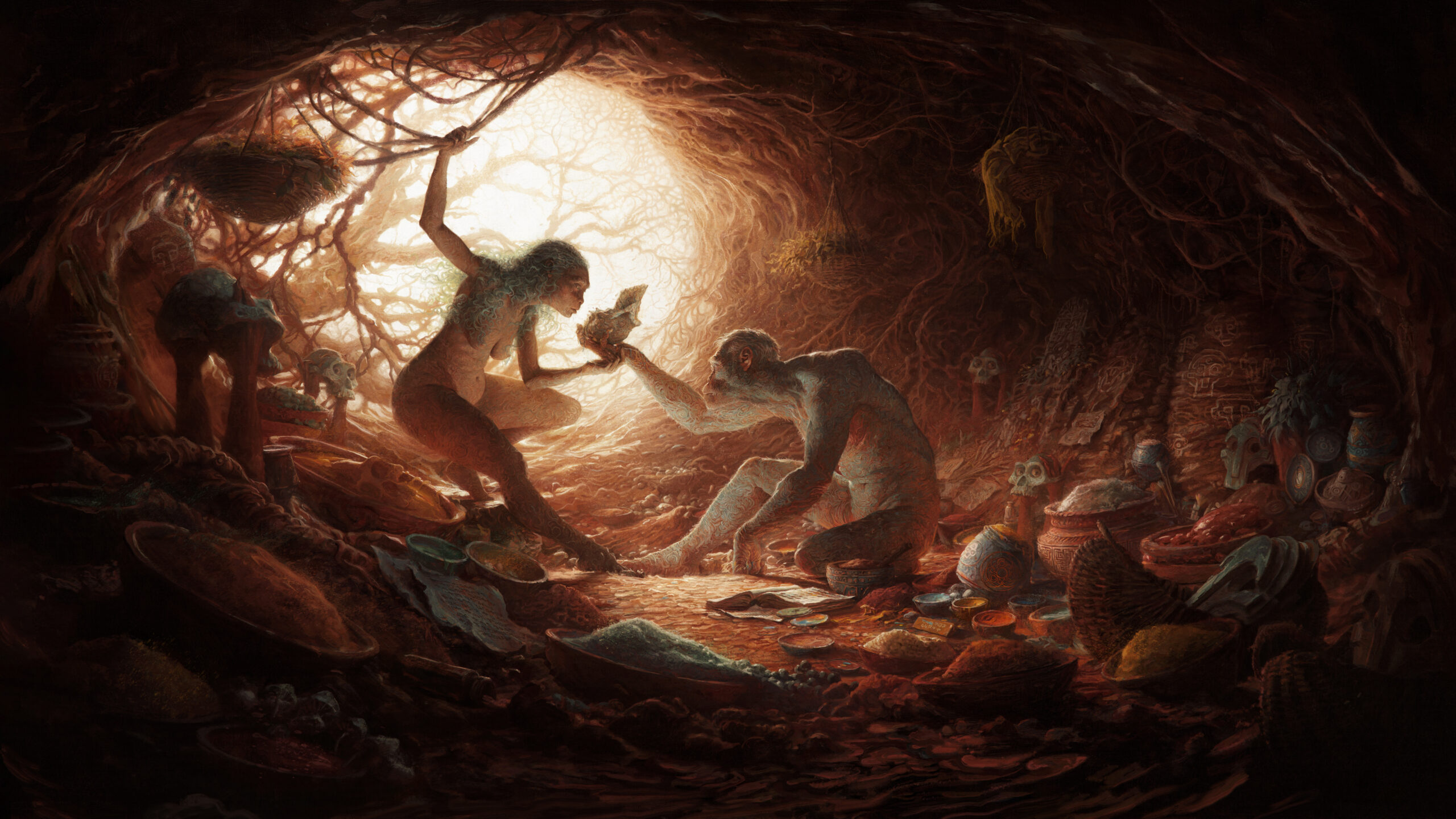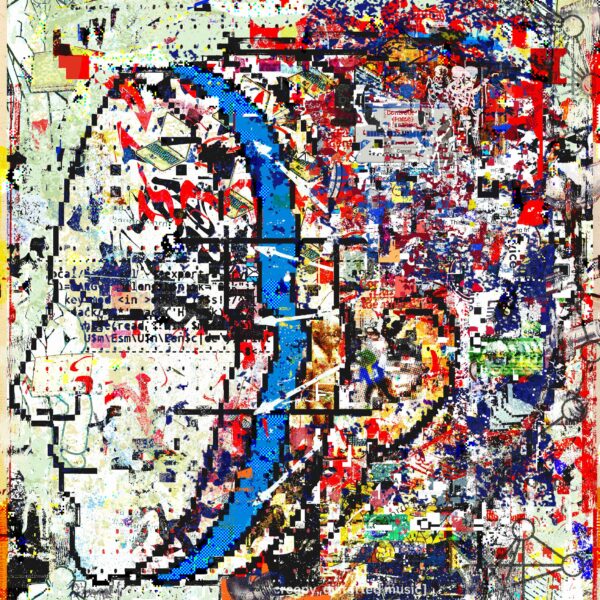Sam Spratt on Starting Anew and ‘VIII. Infinite Ceremony’
Sam Spratt is a New York based artist and rare expert at creating digital works using traditional painting techniques. Spratt’s emotional journey and reinvention of self are as inspirational as his incredible visual work. In this interview, we discuss Spratt’s LUCI collection, the inspiration behind his work, and the evolution of his craft. Please note, this conversation has been edited for brevity and clarity.

Q: Walk me through a little bit of your childhood. Were you always making art? Were you encouraged to?
SPRATT: I’ve always doodled. That was always a current growing up, but what really brought me towards art was love. My senior year of high school, there was this girl who really was the first to ever pay me any mind or attention at all. She had dreams of becoming a fashion designer, knowledge and history of it, and it inspired me. Being a romantic and also not a great student at the time, encouraged me to follow in that artistic direction. However, we ended up breaking up the summer before school began.
Q: How did that romantic inspiration lead you to study art? Did the inspiration stick past the end of the relationship?
SPRATT: Oh yes. So I wound up in art school anyways, just without my primary reason for being there. Even so, sitting in my very first drawing class was an incredible experience. I had never really had anything to target my focus or attention on. I was sitting there in this dust-filled classroom with a giant platform in the middle of it, chairs all around, a bunch of paper bags set up, around the circle were pads of paper and graphite: we were asked to draw a still life. I had never really tried to recreate life in this way. Having this teacher for the first time in my life start giving me these almost shamanistic words of wisdom as we drew changed the way I saw and created. They talked about looking at these things in front of us not as distinct objects, not as a paper bag, a mundane and simple object, but as something that is only formed and visible to you because of what it is reflecting around it. When you’ve got the light pouring in from the window, it’s hitting certain creases the hardest, but it’s also bouncing around this whole room, picking up different colors as it collides around the walls and the surface of the wood that it’s on, and then back up. Every little nook and cranny is going to reveal something very different about it. That tiny absolute mundane art lesson basically upended everything of how I moved through the world, which made the wildly unremarkable, remarkable.
They talked about looking at these things in front of us not as distinct objects, not as a paper bag, a mundane and simple object, but as something that is only formed and visible to you because of what it is reflecting around it.

Q: What was your most important takeaway from your art education?
SPRATT:In that class– I experienced the first moment I could recall resembling achievement through expanding knowledge. Happening on such a tiny scale, but I really can credit pretty much everything that followed from there to something as simple as that first assignment. The assignment was, after the paper bag class, to come back a week later with a greater understanding of these objects by way of recreating them– setting them up and drawing them myself, alone. I would set up these bags, crinkle them up, put some under one lamp, some under two, some under windows to get natural light. My first drawings were: not great; they were truly not very special at all. But there was something incredible to come back into class a week later and have them judged in front of the whole class. Mind you, at school there are parties, there are girls, there’s all kinds of distractions, but I had never had such targeted focus or attention on anything like this in my life. It didn’t really let up after that.
Q: What was your career trajectory after that?
SPRATT: For my first job, I was a staff illustrator for a tech blog. I made about $20 a pop for an image, making little graphics for strange little gossip columns about the latest goings on in the tech industry. My brain at this point was mush. I was a pop culture guy. I was fixated on celebrity, music, games, and tech stuff. I used to be on Tumblr and I would do these maybe now embarrassing or endearingly simple fan arts of TV shows or movies in pop culture. But that shared attention connected me by way of the laws of the meme to real work and jobs.
Q: Did posting your work online serve as a jumping off point for you?
SPRATT: It did. On Tumblr, I made a piece of fanart for a show called Community by Dan Harmon that included Donald Glover in it. Donald Glover’s creative director, Ibra, found me through it and then hired me to create a series of images for one of his early albums. Then Janelle Monáe found me and hired me to create her album artwork, and then Logic found me. I did eight of his albums on increasingly grander scales and budgets and countless jobs came from that. Through Logic, Kid Cudi. Through these branching paths I touched into theater for Tony winning plays and Oscar-winning movie posters. I spent a year working on Red Dead Redemption 2, which when I was hired, they were able to point to the work they wanted in my portfolio, which included many of those artists I work with. So it’s like you can trace this path if you’re paying attention. If you put something out there and it just touches the right collision points, it bounces around to other things. So I guess I see that as both luck, and I spend a lot of time on my work. I do work hard to try to make it better than it was before.

It began as a very lonely, self-serious, emotional, and melodramatic painting series. They begin at this over-earnest place, and the moment you start reflecting that off of other people and their experiences, we realize that there are a lot of us on this trip together.
Q: What drew you to leave the commercial side of art?
SPRATT: It took a series of catalytic events, some death, some relationships endings, for some ugly realities looking back into myself to surface. The personal things were challenging but what stuck hard was how I had dissociated into this strange soup of pop culture that defined my work. I loved working with many of these artists, I learned so much from them, but I missed so much as well. In that whole arc of the 10 years of a career, at one point I forgot that I was an artist with my own life and my own world and my own views and I didn’t notice for a long time because the client list grew and the money was good, and most importantly that I, me, Sam, let those things get in the way. All of these forces colliding at once birthed a desire to make my own world or at least break out of the one I was in. The early iterations of it were very silly. They were sad, very, very emo. But they slowly evolved. Right after I had done Kid Cudi’s last album cover, I did a painting titled Slipspace, which I have not minted yet. That was the birth of Luci before Birth of Luci– in it was this sense of awe and surrender, we can live a lot of life, and we can miss key elements of it along the way. It’s tricky when you pick it up later and try to make sense of it.
Q: What do you think the most major growth points have been for your skill as an artist?
SPRATT: If you look at my early work, you can see how reliant I was on photographic realism. You can see how my understanding of color, light, and composition was weaker. But mostly there is just no story. It is not my world. You can see every little thing of what it means to be an artist and to grow and struggle, hidden under the surface. But I think most of it, when you look through the old commercial work and you contrast it with LUCI, I think you can really see what it is when all someone is able to preserve is just a tiny bit of themselves as they try to execute someone else’s world.
Q: Can you expand a bit on the genesis of LUCI?
SPRATT: LUCI is very much about starting anew. As I’ve gotten closer to other artists in the space– people who have built platforms, engineers, market analysts, lawyers, all kinds of people– I’ve seen the very isolated atomized experience of starting over be shared. Starting anew is very common. It’s not a special story. It’s actually very liberating to see how uncommon it is that this tiny little corner of the internet is actually has this bizarrely high-frequency of people who were not on the absolute wrong path before, but certainly on one where they felt a little bit of decay in their own life, where the patterns or rituals were just very cyclical. Sharing LUCI has been a rather amazing experience. It began as a very lonely, self-serious, emotional, and melodramatic painting series. They begin at this over-earnest place, and the moment you start reflecting that off of other people and their experiences, we realize that there are a lot of us on this trip together.

She was the first woman I met that really untethered me.
Q: Where does Slipspace fit in for you emotionally and chronologically? What’s the story of that piece?
SPRATT: I made Slipspace right after I finished Kid Cudi’s last album cover Man on the Moon III. You can see the color palette similarities and stylistic overlap. But to put you in my headspace at that time: It was this huge honor and excitement to get to work with an artist who I admired. We made that album cover in four days back and forth without really sleeping. But prior to taking it on, I was already having feelings of, “I got to make my own world. What is this? What do I have to say?” So when the album cover came out, and I put it out there. I got the feeling I always get from an album cover, just at a grander scale. After a day of feeling the glow, that little dopamine hit of having art publicly there in the world that I knew was on a bunch of my friend’s spotify players, it faded. So I made Slipspace. A painting which was born largely from meeting who, now a little over or three years later, has become my wife.
Q: What happened when you met? How did that change your art and your worldview?
SPRATT: She was the first woman I met that really untethered me. I was this clenched, tight-fisted, hyper detailed person that would just sit and focus on this one singular thing forever. She entered my life and showed me a power that comes from letting go of that at times so that I have something to bring back. That first LUCI painting: Slipspace, when I look at it now, it’s a very over-the-top representation of a very real feeling. All of LUCI is based on these things that are overly earnest, real thoughts. I really mean them when I make them. But, through the actual creation process, I get to say goodbye to feeling something that intensely. It’s sort of a way of letting go. Don’t go back there. Grow. The next year, I spent both studying the NFT space and creating the first three pieces of LUCI;, Birth of Luci, Lullabies for Isaac, and First Sacrifice, which comprise LUCI: Chapter 1. I think that was the first time in my life I’d really just put aside everything else. I shut out clients. I shut out doing other things and dedicated this time to myself, and I am glad I did.

Q: Can you give us a preview of the piece you are creating for AOTM? What is it about? What was the process of making it?
SPRATT: Sure. In the Trailer for LUCI: Chapter 4 “VIII. Infinite Ceremony”, there is some time lapse footage of its creation process inside it, paired with the written words that accompany each of my paintings. I write these psalms as the lore of LUCI. A layer of richness of the arc for people paying closer attention can dive into, but not essential to see what Luci is. The next painting is titled VIII. Infinite Ceremony. It is a painting about love and sacrifice. That in order to make a grand commitment in your life, you have to be flayed open, by your own choice, and through your own hard work. To let a divine union, something we’ve been doing for millenia, truly into your life. That if you really want to build something strong, your reality and your life’s partner’s reality must be shared, however brutally. To build that, you must ensure there’s nothing in the way between you. Making sure the increments break down so much that the truth between two people can exist not just in words or actions but in atoms and time, in a spectrum of life under this one— that the ugliest bits and the most beautiful are there on the table to be examined, nurtured, and designed when in unison: to grow.


